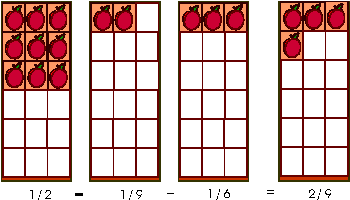Addition
Example
In the example above fractions 1/3 + 1/3 may be combined to give
(1 + 1) / 3 since they have the same denominator, the new numerator
is the sum of the old numerators, the new denominator is the common
denominator 3.

In the pie chart illustration above, the blue area of the first pie is 1/3 and the blue area of the second pie is 1/3. The sum of the 2 blue areas is 1/3 + 1/3 which is equal to 2/3. The third pie shows the sum of the blue areas of the first two pies.
Example
In the example above fractions 1/2 + 1/3 can not be combined as in example 1 because they do not have the same denominator. Fractions 1/2 and 1/3 have the least common denominator (LCD) of 6. Therefore, fraction 1/2 has to be multiplied by 3/3 to make 3/6 and fraction 1/3 has to be multiplied by 2/2 to make 2/6.
Now add fractions 3/6 and 2/6 as in example 1 because they have the same common denominator.
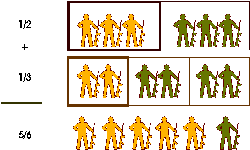
In the marching men example, 3 men with orange uniform from the first group and 2 men with orange uniform from the second group makes 5 men with orange uniform.
Example
In the example above fractions 1/2 + 1/9 + 1/6 have the least
common denominator (LCD) of 2 x 3 x 3 = 18. Therefore, fraction 1/2
has to be multiplied by 9/9 to make 9/18. Fraction 1/9 has to be
multiplied by 2/2 to make 2/18 and fraction 1/6 has to be multiplied by 3/3 to make 3/18.
Now add 9/18, 2/18, and 3/18 together because they have the same denominator.
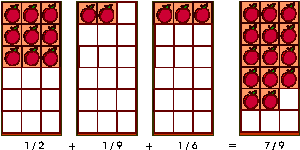
Example
In the example above fractions 2/3 - 1/3 may be subtracted to give (2 - 1) / 3 since they have the same denominator, the new numerator is the difference of the old numerators, the new denominator is the common denominator 3.
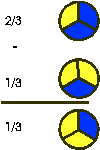
Example
In the example above fractions 1/2 - 1/3 can not be subtracted as
in example 1 because they do not have the same common denominator.
Fractions 1/2 and 1/3 have the least common denominator (LCD) of 6.
Therefore, fraction 1/2 has to be multiplied by 3/3 to make 3/6 and
fraction 1/3 has to be multiplied by 2/2 to make 2/6.
Now subtract fractions 3/6 and 2/6 as in example 1 because they have the same common denominator.
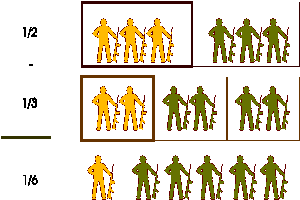
Example
In the example above fractions 1/2 - 1/9 - 1/6 have the least common denominator (LCD) of 2 x 3 x 3 = 18. Therefore, fraction 1/2 has to be multiplied by 9/9 to make 9/18. Fraction 1/9 has to be multiplied by 2/2 to make 2/18 and fraction 1/6 has to be multiplied by 3/3 to make 3/18.
Now subtract 9/18, 2/18, and 3/18 because they now have the same common denominator.
